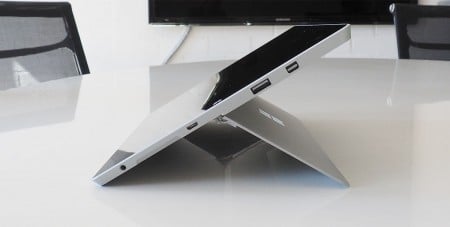That being said, it’s not a vast improvement on some of the budget machines we’ve seen this year, if any at all, but where the Surface 3 wins points is that middle hybrid ground.
You see, it’s technically not a laptop, and thanks to its 622 gram weight — almost 200 grams lighter than the Surface Pro 3 — it manages to offer a premium tablet experience, which you can quickly upgrade with a TypeCover, a soft microsuede-covered keyboard with actual physical keys and a button-based touchpad.
Like the previous Surface models, this magnetic clicks into place at the bottom of the Surface, turning the Surface 3 into something like a book, and together with the kick stand built into the Surface 3, essentially makes the Surface 3 into a laptop. Ish.
For most work — indeed, for this review — the optional $149 TypeCover is an excellent addition, and it might even have improved, with Microsoft telling us it now has improved striking distance and a sound dampener on the keys.
Essentially, it’s a similar keyboard to the larger one our Surface Pro 3 relies on, and while it’s technically compatible, it looks a little silly connected to each device (the Pro 3 keyboard looks oversized on the Surface 3, while the Surface 3 keyboard looks undersized on the Pro 3).

Our experience with the keyboard, however, feels the same, or close to the same with the Surface 3, with a close-to-identical keyboard size on the Surface 3, even if some of the key sizes have changed.
They’re not bad changes though, not like when companies decide to change the size of a shift key or move keys altogether, and if you’re used to a good keyboard, you’ll get used to the Surface 3 TypeCover very, very quickly.
We only hope it lasts longer than what we found on the Surface Pro 3, but time will tell for that one, so we’ll just have to keep using it.
As for the kick stand, it’s not the same excellent “this will work in any configuration” kick stand we saw on the Surface Pro 3, which is a bit of a shame.
Instead, this is a three-point kick stand, offering a stand up, a more relaxed stand up, and a position close to lying down that isn’t so you can play games our do other things without the tablet totally being flat.
It’s not as great an inclusion as the one on the Surface Pro 3, but we suspect they have to leave something aside for higher-end processing, and we’re told leaving this in would affect size and weight, which the consumer crowd thinking of a $600 machine are probably factoring in.

They’re also probably thinking about battery life, and we are too.
We loved the Surface Pro 3, but battery life was definitely not its forte, and over six months in, we can tell you not much has changed, with the Pro model offering around 4 to 5 hours of use, though it usually edges closer to that 4 hour mark.
On the Surface 3, however, the Intel Atom has helped a great deal. In fact, our testing of using the computer revealed closer to 6 to 7 hours of use for general work, before the battery screamed it was time to plug it in.
And that’s where another positive point is found for the Surface 3: no more proprietary charge port.
Yes, Microsoft may have at least tried to do something good when it introduced a proprietary magnetic charge port with the first few Surface models, changing it again with a more reliable flat connector, but in the Surface 3, it has done something even better.
It has gotten rid of the proprietary connection. All of them.
Instead, charging the Surface 3 is handled via a microUSB port, which is probably the most widely found charge port in the world today, due to how many phones, tablets, computers, headphones, and other random gadgets are around that sport the port.
Microsoft’s Surface 3 is no different, and while it comes with its own little charging block, it can be charged by even a lowly microUSB phone charger, confirmed from a test where we plugged in a fairly old Samsung microUSB charge block that we think might have been from a Galaxy S3.
Yes, we still have old charging blocks.













